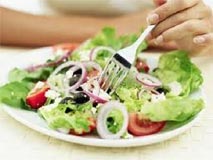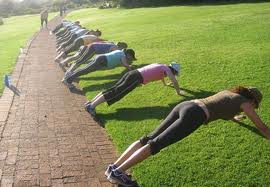5 Steps To Looking 10 Years Younger
By Steve & Becky Holman

Did you know that once you hit 40 years of age, whether you're a man or a women, your body starts aging FASTER than normal? Studies have shown that without the proper nutrients and exercise, your body will age about 6 months EXTRA for every year that passes. Think about that! If you are 40, that means by the time you hit 44 you will LOOK and FEEL 48. And by the time you reach 60, you will LOOK and FEEL 70 YEARS OLD! We see this every day... just look around you.
Did you know that 90% of people over the age of 35 lose enough muscle every year to burn off an additional 4 pounds of body fat? That means you not only lose the only thing on your body that creates shape, tone, and strength—you also gain more fat every year, even if your calories stay the same.
Did you know that all of this is reversible at any age? That there are specific ways to move, eat, and think that tell your brain to STOP this rapid aging process... and even SLOW IT DOWN to the point where you're aging less than a year for every year? That means you can look younger at 40 than you do at 35... or if you're like Becky and I, younger at 50+ than we did at 40!
This is not fantasy talk. This does not require a boatload of anti-aging drugs, supplements, or gimmicks. And, this works for anyone, male or female, and works at any age. 35, 45, 55, 65, 75... you name it. The biology is exactly the same.
My years as editor-in-chief at Iron Man Magazine have allowed me to peer into the secret routines of the anti-aging experts. Over the years, both Becky and I have picked up SO many tips, tricks, and strategies that have allowed us to literally reverse the aging process, at least from a cellular level. That means our body's look, feel, and MOVE younger than our chronological age.
We've taught this System to countless men and women over the years, and it always begins with these 5 key principles you must apply in order to STOP the rapid onset of aging that's going on right now, reverse it, and begin "aging backwards" by restoring your body's natural youth hormones.
That said, we have to warn you: What you are about to hear may go against all the conventional diet and exercise advice you've been hearing. That's because the world has, to be utterly frank, gone soft! "Core training", hot yoga, spin classes, tai chí all of these are just fine, but they won't slow your aging, and they certainly will never shape your muscles or burn off stubborn body fat. No way!
These 5 steps reveal the things you absolutey MUST AVOID if you want to slow the aging process, reclaim your health, and achieve your ideal body.
What you need is a splash of cold water, a touch of Old School, and the honest truth. Sound good? Let's dive in!
Step 1: Forget Low-Fat Diets

Low fat
everything has been the craze now for decades and look around. What has that wonderful bit of advice done for the bodies you see? We're fatter, sicker, and more addicted to sugar and carbs than any other time in history.
And, we're passing these habits to our kids.
Fats are not to be feared – they're to be embraced. They do not make you fat; rather, they help your body regenerate your power hormones. Testosterone, the 'strength' hormone, for example, is the direct result ofcholesterol and dietary fat intake. That's right: "Cholesterol" isn't a dirty word! Your body needs dietary fat and cholesterol in order to produce ANY AND ALL vital hormones.
People on low fat diets look drawn, gaunt, and weak. They are often sick, sometimes to the point of literally breaking down. And, they can never just enjoy eating out. Every meal and every gram must be accounted for. Do you really think this will make you younger? Of course not... it will worry you to death if it doesn't kill you first!

Step 2: Stop Spinning: You're Just Spinning Your Wheels

Spinning classes can be fun, if you like sitting in one place and torturing yourself. But have you noticed how
little people change their bodies in these classes? Sure, it's good "cardio", but cardiovascular conditioning can be gained with far less time and effort.
Spinning, and any form of endurance training (especially running) does very little to help the age reversal process. Many times, these long-duration exercise bouts accelerate the aging process by increasing free radicals. These free radicals are scavengers that prey on your body's essential nutrients and tissues.
There's a
smart way to exercise... we'll cover that in a minute. And, what's wonderful is that it takes you about ¼ the time of traditional workouts. We'll cover more details on the next page.

Step 3: Stop Blaming Everything On How Old You Are

The guys to the left are not fat because they are old—they're fat because
they eat, think, and move like a fat, old, dying person! Becky and I are both in our 50s—older than the guys in this photo—and I still sport a nice six-pack, and Becky transformed her body from the typical "middle age mom" to a slim, toned, and super-sexy woman who looks 10 years younger. (See the next page for photos!)
Listen: Your body doesn't own a clock. Studies have shown that men and women in their 90s were able to gain muscle tone in just a matter of weeks of simple weight training. I've personally seen men and women transform their physiques at literally all ages—25 to 95!
If you're around those naysayers who are constantly talking about growing old, all their aches and pains, and how life is just down hill after 40—LEAVE! Surround yourself with positive thinkers who absolutely crave a challenge. A challenge is what keeps you YOUNG, and the best challenge there is happens to be taking control of your health and body.
We'll show you HOW we do that on the
next page.

Step 4: Avoid Chronic Dehydration

Water isn't just "good for you" — water
burns fat. Water
suppresses hunger. Water renews your skin. Just drinking 12 ounces of pure water every day can take a few years off your face in a matter of weeks. You'll also drop fat, have more energy, and save your kidneys and liver from chronic overwork.
When your kidneys are taxed from too little water, your liver has to take over. Now, get this: Your liver is your number one fat-burning organ. Do you REALLY want it processing liquids and toxins rather than BURNING FAT? No way, right? Well, grab a glass of water, and watch the mirror. Within a few weeks, the change to your face and body will be noticeable.

Step 5: Work Out LESS (Yes, Less)

If you don't work out at all, you're going to lose muscle tissue every year. That means you'll get fatter and flabbier each and every year with less shape and more sag. Is this what you desire? No way, right?
Well, the answer is old school resistance training. Here's the secret: hardly anyone is doing it right!
Becky and I have seen literally thousand of pro fitness athletes train over the years. The ones who looked the best — and that means looked the youngest, most toned, and had the least amount of unwanted fat — were the ones who left the gym while others were still warming up!
Over the past decade, Becky and I have developed a men and women's workout system that we call
F4X Training System. This is a revolutionary way of combining
four specific exercises done in literally a matter of minutes. That's ALL YOU NEED... And don't let anyone tell you otherwise!
That's right: We do not do endless cardio sessions (the
F4X Training System is a great cardiovascular workout) and we do not spend an hour a day in the gym. We have a life, thank you. We have kids, and we value being
both fit and real people at the same time. The F4X Training System was our personal breakthrough to achieving our ideal bodies, staying in tip-top shape with minimal time, and having a life outside a gym.

WARNING: THIS IS NOT FOR EVERYONE!
We're not going to lie to you: The F4X System is definitely not for everyone. For example:
- If you enjoy spending an hour a day working out, this is NOT for you (and good luck with those free radicals!)
- If you think you can "spin" or run your way to a younger, time-changing body, have at it... this is not for you.
- And, if you are not prepared to work very, very hard for a very short period of time, this is not for you.
We're not going to lie: F4X is hard work — anything that produces this kind of radical age-defying result will never be a walk in the park.
However, it's FAST it's EFFICIENT and it's SAFE. Fair enough? Hey, if you're looking for an EASY way out, then Google "Pipedream Workout" and maybe you'll get lucky. If you want results that have stood the test of DECADES, then read on.
You MUST be okay with brief bouts of old-school-style hard work. If you are, here's a routine you've never seen before, AND you will get in and out of the gym in RECORD time.
"So, what do I do next?"
If you are really ready to get started on our exact Old School, New Body System that features our F4X Training Program, the OSNB Ageless Nutrition Plan, and all of our anti-aging secrets and protocols, then click the button below and we'll take you to the next page.
On the very next page, we'll let you in on the specifics of our System, and how you can get started within less than 30 minutes from now.










 Did you know that once you hit 40 years of age, whether you're a man or a women, your body starts aging FASTER than normal? Studies have shown that without the proper nutrients and exercise, your body will age about 6 months EXTRA for every year that passes. Think about that! If you are 40, that means by the time you hit 44 you will LOOK and FEEL 48. And by the time you reach 60, you will LOOK and FEEL 70 YEARS OLD! We see this every day... just look around you.
Did you know that once you hit 40 years of age, whether you're a man or a women, your body starts aging FASTER than normal? Studies have shown that without the proper nutrients and exercise, your body will age about 6 months EXTRA for every year that passes. Think about that! If you are 40, that means by the time you hit 44 you will LOOK and FEEL 48. And by the time you reach 60, you will LOOK and FEEL 70 YEARS OLD! We see this every day... just look around you. Low fat everything has been the craze now for decades and look around. What has that wonderful bit of advice done for the bodies you see? We're fatter, sicker, and more addicted to sugar and carbs than any other time in history. And, we're passing these habits to our kids.
Low fat everything has been the craze now for decades and look around. What has that wonderful bit of advice done for the bodies you see? We're fatter, sicker, and more addicted to sugar and carbs than any other time in history. And, we're passing these habits to our kids.
 Spinning classes can be fun, if you like sitting in one place and torturing yourself. But have you noticed how little people change their bodies in these classes? Sure, it's good "cardio", but cardiovascular conditioning can be gained with far less time and effort.
Spinning classes can be fun, if you like sitting in one place and torturing yourself. But have you noticed how little people change their bodies in these classes? Sure, it's good "cardio", but cardiovascular conditioning can be gained with far less time and effort. The guys to the left are not fat because they are old—they're fat because they eat, think, and move like a fat, old, dying person! Becky and I are both in our 50s—older than the guys in this photo—and I still sport a nice six-pack, and Becky transformed her body from the typical "middle age mom" to a slim, toned, and super-sexy woman who looks 10 years younger. (See the next page for photos!)
The guys to the left are not fat because they are old—they're fat because they eat, think, and move like a fat, old, dying person! Becky and I are both in our 50s—older than the guys in this photo—and I still sport a nice six-pack, and Becky transformed her body from the typical "middle age mom" to a slim, toned, and super-sexy woman who looks 10 years younger. (See the next page for photos!) Water isn't just "good for you" — water burns fat. Water suppresses hunger. Water renews your skin. Just drinking 12 ounces of pure water every day can take a few years off your face in a matter of weeks. You'll also drop fat, have more energy, and save your kidneys and liver from chronic overwork.
Water isn't just "good for you" — water burns fat. Water suppresses hunger. Water renews your skin. Just drinking 12 ounces of pure water every day can take a few years off your face in a matter of weeks. You'll also drop fat, have more energy, and save your kidneys and liver from chronic overwork. If you don't work out at all, you're going to lose muscle tissue every year. That means you'll get fatter and flabbier each and every year with less shape and more sag. Is this what you desire? No way, right?
If you don't work out at all, you're going to lose muscle tissue every year. That means you'll get fatter and flabbier each and every year with less shape and more sag. Is this what you desire? No way, right?